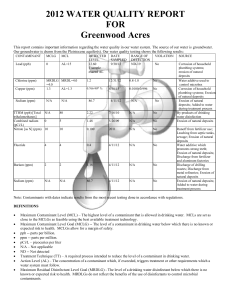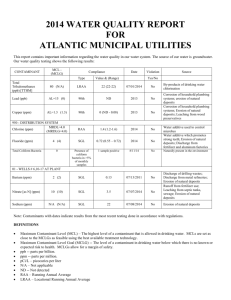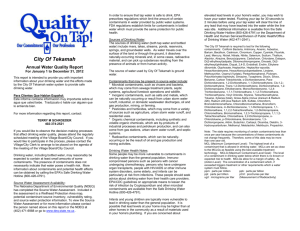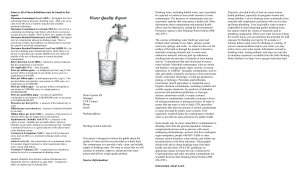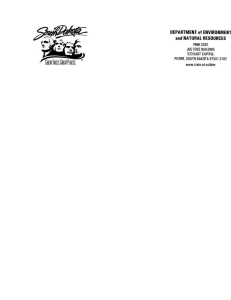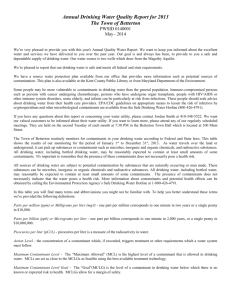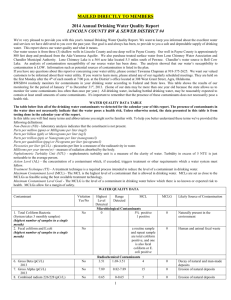irections for completing - Town of Ossian, Indiana
advertisement
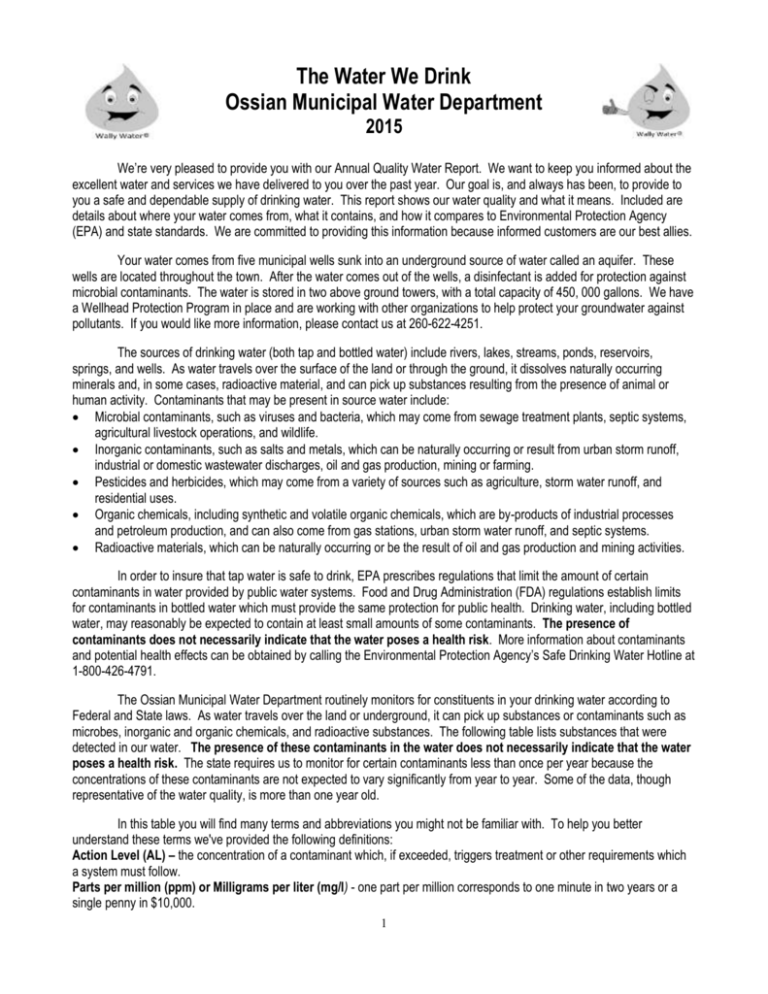
The Water We Drink Ossian Municipal Water Department 2015 We’re very pleased to provide you with our Annual Quality Water Report. We want to keep you informed about the excellent water and services we have delivered to you over the past year. Our goal is, and always has been, to provide to you a safe and dependable supply of drinking water. This report shows our water quality and what it means. Included are details about where your water comes from, what it contains, and how it compares to Environmental Protection Agency (EPA) and state standards. We are committed to providing this information because informed customers are our best allies. Your water comes from five municipal wells sunk into an underground source of water called an aquifer. These wells are located throughout the town. After the water comes out of the wells, a disinfectant is added for protection against microbial contaminants. The water is stored in two above ground towers, with a total capacity of 450, 000 gallons. We have a Wellhead Protection Program in place and are working with other organizations to help protect your groundwater against pollutants. If you would like more information, please contact us at 260-622-4251. The sources of drinking water (both tap and bottled water) include rivers, lakes, streams, ponds, reservoirs, springs, and wells. As water travels over the surface of the land or through the ground, it dissolves naturally occurring minerals and, in some cases, radioactive material, and can pick up substances resulting from the presence of animal or human activity. Contaminants that may be present in source water include: Microbial contaminants, such as viruses and bacteria, which may come from sewage treatment plants, septic systems, agricultural livestock operations, and wildlife. Inorganic contaminants, such as salts and metals, which can be naturally occurring or result from urban storm runoff, industrial or domestic wastewater discharges, oil and gas production, mining or farming. Pesticides and herbicides, which may come from a variety of sources such as agriculture, storm water runoff, and residential uses. Organic chemicals, including synthetic and volatile organic chemicals, which are by-products of industrial processes and petroleum production, and can also come from gas stations, urban storm water runoff, and septic systems. Radioactive materials, which can be naturally occurring or be the result of oil and gas production and mining activities. In order to insure that tap water is safe to drink, EPA prescribes regulations that limit the amount of certain contaminants in water provided by public water systems. Food and Drug Administration (FDA) regulations establish limits for contaminants in bottled water which must provide the same protection for public health. Drinking water, including bottled water, may reasonably be expected to contain at least small amounts of some contaminants. The presence of contaminants does not necessarily indicate that the water poses a health risk. More information about contaminants and potential health effects can be obtained by calling the Environmental Protection Agency’s Safe Drinking Water Hotline at 1-800-426-4791. The Ossian Municipal Water Department routinely monitors for constituents in your drinking water according to Federal and State laws. As water travels over the land or underground, it can pick up substances or contaminants such as microbes, inorganic and organic chemicals, and radioactive substances. The following table lists substances that were detected in our water. The presence of these contaminants in the water does not necessarily indicate that the water poses a health risk. The state requires us to monitor for certain contaminants less than once per year because the concentrations of these contaminants are not expected to vary significantly from year to year. Some of the data, though representative of the water quality, is more than one year old. In this table you will find many terms and abbreviations you might not be familiar with. To help you better understand these terms we've provided the following definitions: Action Level (AL) – the concentration of a contaminant which, if exceeded, triggers treatment or other requirements which a system must follow. Parts per million (ppm) or Milligrams per liter (mg/l) - one part per million corresponds to one minute in two years or a single penny in $10,000. 1 Parts per billion (ppb) or Micrograms per liter - one part per billion corresponds to one minute in 2,000 years, or a single penny in $10,000,000. Picocuries per liter (pCi/L) - picocuries per liter is a measure of the radioactivity in water. Maximum Contaminant Level - The “Maximum Allowed” (MCL) is the highest level of a contaminant that is allowed in drinking water. MCLs are set as close to the MCLGs as feasible using the best available treatment technology. Maximum Contaminant Level Goal - The “Goal” (MCLG) is the level of a contaminant in drinking water below which there is no known or expected risk to health. MCLGs allow for a margin of safety. Maximum Residual Disinfectant Level (MRDL) – The highest level of a disinfectant allowed in drinking water. There is convincing evidence that addition of a disinfectant is necessary for control of microbial contaminants. Maximum Residual Disinfectant Level Goal (MRDLG) – The level of a drinking water disinfectant below which there is no known or expected risk to health. MRDLGs do not reflect the benefits of the use of disinfectants to control microbial contaminants. Non-Detects (ND) – Laboratory analysis indicates that the constituent is not present. TEST RESULTS Contaminant Violation Y/N Results Units MCLG MCL Likely Source of Contamination Disinfection Byproducts and Precursors (August 2014) Total Haloacetic Acids (Haa5) Range 1.1-2.0 Total Trihalomethanes (TTHM) Range 0.6-8.3 No 1.6 (avg.) ppb N/A 60 Byproduct of drinking water chlorination No 4.6 (avg.) ppb N/A 80 Byproduct of drinking water chlorination Radiological Contaminants (October 2013) Gross Beta Particle Activity Range 1.3-4.6 Gross Alpha, including Ra, excld. 2.0-5.4 Radium, Combined (226, 228) Range .49-1.75 No 2.74±.66 (avg.) pCi/L 0 50 Decay of natural and man-made deposits No 3.9±.88 (avg.) pCi/L 0 15 Erosion of natural deposits No 1.46±.59 (avg.) pCi/L 0 5 Erosion of natural deposits Uranium Range .18-.44 No .31±.03 (avg.) pCi/L 0 20.3 Erosion of natural deposits ppb 0 10 ppm 2 2 ppm 1.3 AL=1.3 Erosion of natural deposits; runoff from orchards; runoff from glass and electronics production wastes Discharge of drilling wastes; discharge from metal refineries; erosion of natural deposits Corrosion of household plumbing systems; erosion of natural deposits; leaching from wood preservatives Results Units MCLG MCL 0.8 (avg.) 01.00 (90th %) ppm 4 4 ppm 0 AL=15 0.40 (avg.) mg/L Inorganic Contaminants (May & July 2014) Arsenic (2014) Range 2.1-4.6 Barium Range 0.0072-.012 Copper (2012) No Contaminant Violation Y/N No No No # of samples above AL=0 Fluoride Range .7-.9 Lead (2012) No # of samples above AL=0 4.0 (avg.) 0.0108 (avg.) 0.35 (90th %) Likely Source of Contamination Erosion of natural deposits; water additive which promotes strong teeth; discharge from fertilizer and aluminum factories Corrosion of household plumbing systems, erosion of natural deposits. Residual Disinfectant (2014) Chlorine Residual Range .02-2.10 No 4 MRDL 2 Naturally present in the environment Synthetic Organic Compounds (SOC’s) (2012) Di(2ethylexyl)phthalate Range .6-1.0 No 0.7 (avg.) ppb 6 Discharge from rubber and chemical factories If present, elevated levels of lead can cause serious health problems, especially for pregnant women and young children. Lead in drinking water is primarily from materials and components associated with service lines and home plumbing. The Town of Ossian is responsible for providing high quality drinking water, but cannot control the variety of materials used in plumbing components. When your water has been setting for several hours, you can minimize the potential of lead exposure by flushing your tap for 30 seconds to 2 minutes before using the water for drinking or cooking. If you are concerned about lead in your water, you may wish to have your water tested. Information on lead in drinking water, testing methods, and steps you can take to minimize exposure is available from the Safe Drinking Water Hotline or at http://www.epa.gov/safewater/lead. We’re proud that your drinking water meets or exceeds all Federal and State requirements. We have learned through our monitoring and testing that some constituents have been detected. The EPA has determined that your water IS SAFE at these levels. MCL’s are set at very stringent levels. To understand the possible health effects described for many regulated constituents, a person would have to drink 2 liters of water every day at the MCL level for a lifetime to have a one-in-amillion chance of having the described health effect. Some people may be more vulnerable to contaminants in drinking water than the general population. Immunocompromised persons such as persons with cancer undergoing chemotherapy, persons who have undergone organ transplants, people with HIV/AIDS or other immune system disorders, some elderly, and infants can be particularly at risk from infections. These people should seek advice about drinking water from their health care providers. EPA/CDC guidelines on appropriate means to lessen the risk of infection by cryptosporidium and other microbiological contaminants are available from the Safe Drinking Water Hotline at 1-800-426-4791. Thank you for allowing us to continue providing your family with clean, quality water this year. In order to maintain a safe and dependable water supply we sometimes need to make improvements that will benefit all of our customers. These improvements are sometimes reflected as rate structure adjustments. Thank you for understanding. If you have any questions about this report or concerning your water utility, please contact Luann Martin at 260622-4251. We want our valued customers to be informed about their water utility. If you want to learn more, please attend any of our regularly scheduled town board meetings. They are held on the second Monday of each month at 7:00 p.m. at the Town Hall located at 507 N. Jefferson Street in Ossian. Please call our office at 260-622-4251 if you have questions. We at the Ossian Municipal Water Department work around the clock to provide top quality water to every tap. We ask that all our customers help us protect our water sources, which are the heart of our community, our way of life and our children’s future. 3
